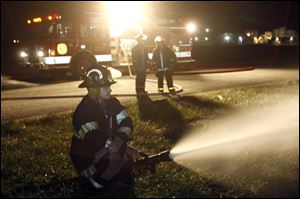
Volunteer firefighters battle dwindling ranks
12/10/2006
Oregon firefighter Phil Jimenez participates in a winter pump operation drill. Changing lifestyles mean fewer volunteers are willing to serve on area fire departments, officials say.
When flames erupted from a barn stocked with bales of straw and hay east of Findlay in October, the Vanlue Volunteer Fire Department was notified of the emergency.
Six firefighters responded out of the 24 on its roster.
"There's no way three or four guys can battle a fully involved barn fire or house fire," Vanlue Fire Chief Bill Drown said. "You can just do the initial attack."
The lack of volunteers able to respond to the 10 a.m. blaze on County Road 197 forced the chief to call the Hancock County Sheriff's Office for mutual aid from neighboring fire departments to have enough manpower to get a handle on the fire.
The number of firefighters willing or able to volunteer their time for their communities has been on the decline in northwest Ohio and southeast Michigan for several years.
In Ohio, the tally of volunteer firefighters has dropped from 34,000 to 30,000 in the past decade, even though 75 percent of the state's fire departments are manned by volunteer personnel, said Shane Cartmill, spokesman for the Division of State Fire Marshal.
Several area fire chiefs ticked off a number of reasons they believe can be attributed to the slide, including a growing number of family demands; children in multiple, year-round sports; longer work commutes; two-income households; additional fire and emergency medical training requirements, and not enough time to do volunteer work.
"Ten to 20 years ago, it was not a problem to get volunteers, but because of the lifestyles that everyone has now ... volunteerism is dwindling quite substantially," said Mike Yunker, mayor of suburban Holland just west of Toledo, who was a volunteer firefighter for 11 years.
Trends around the area are similar to those across the nation.
Of the more than 1.1 million firefighters in the United States, 72 percent are volunteers, and the other 28 percent have made firefighting their careers, according to 2005 statistics compiled by the National Fire Protection Association.
That 72 percent equates to 823,650 volunteer firefighters across the nation, down from 838,000 in 1995, the group reported.
The numbers have been sinking even though most departments aren't picky about who wants to join.
"We'll accept anybody that is willing to work with the fire department, willing to go through the state training, and willing to volunteer their time," Chief Drown said.
Low numbers of volunteers became such a serious problem in Holland last year that the village dissolved its fire department and contracted with neighboring Springfield Township for fire and emergency medical services.
"Response time and the amount of personnel wasn't what I would call appropriate in the way of providing safety in the community, which is why we started looking at different means," Mr. Yunker said, adding that the partnership has worked well.
But compounding the problem for many stations is that most volunteers are unavailable during the morning and early afternoon because there's been a general movement away from second and third-shift work in favor of working a 9-to-5 job, said Ray Walendzak, secretary of the Northwest Ohio Volunteer Fire Department Association.
"We've discussed the shortage of firefighters during the day at many of our meetings," said Mr. Walendzak, who also is the fire chief for the Oregon Fire Department in Lucas County. "That's a problem that we're all trying to solve. We don't have the answer."
One department that has skirted the problem so far is the Archbold-German Township Fire Department in Fulton County, which has a roster of 37 volunteers, most of whom work days.
"We're fortunate enough that we have quite a bit of industry within our village and a number of our volunteers work here in Archbold," Fire Chief Andrew Brodbeck said. "If there's a fire or serious situation like that, our people can leave work and respond to the calls. All we can do is encourage them to show up whenever they're available."
Because of a lack of volunteers during the day, Bedford Township Fire Chief John Bofia said he's constantly monitoring response time on emergency runs and the number of volunteers who show up.
"We watch those, and if there's a significant change, we have to find somebody to take care of it, whether it's mutual aid or manpower in different ways," he said.
Several chiefs said their departments often will rely on mutual aid to have enough manpower to cover the daytime shifts when most volunteers are at work.
If a major emergency breaks out between 7 a.m. and 5 p.m., Vanlue Fire Chief Bill Drown said he tells his firefighters to automatically call mutual aid because he anticipates it will be needed for the extra manpower and additional equipment to help haul water.
Fire Marshal spokesman Shane Cartmill said another solution chiefs should consider is thinking creatively when recruiting new members, instead of simply marketing to young men in their 20s and 30s.
"They're missing women, retirees who are healthier and living longer, and people in their 50s and 60s who are in great shape and could help out," he said.
Ohio's Division of Emergency Medicine is conducting a study to determine why people do not sign up as volunteer firefighters, said Mike Glenn, assistant administrator.
He said the study, paid for with a $95,000 grant from the Ohio Department of Health, also will look at how EMS volunteers can better prepare themselves for a large-scale disaster, even with fewer people doing the job.
"We're continuing to try to figure out a solution," said Mr. Walendzak of Oregon, who recently retired from the state EMS board. "Most volunteer fire departments have to work on it."
Contact Erika Ray at: eray@theblade.com or 419-724-6088.